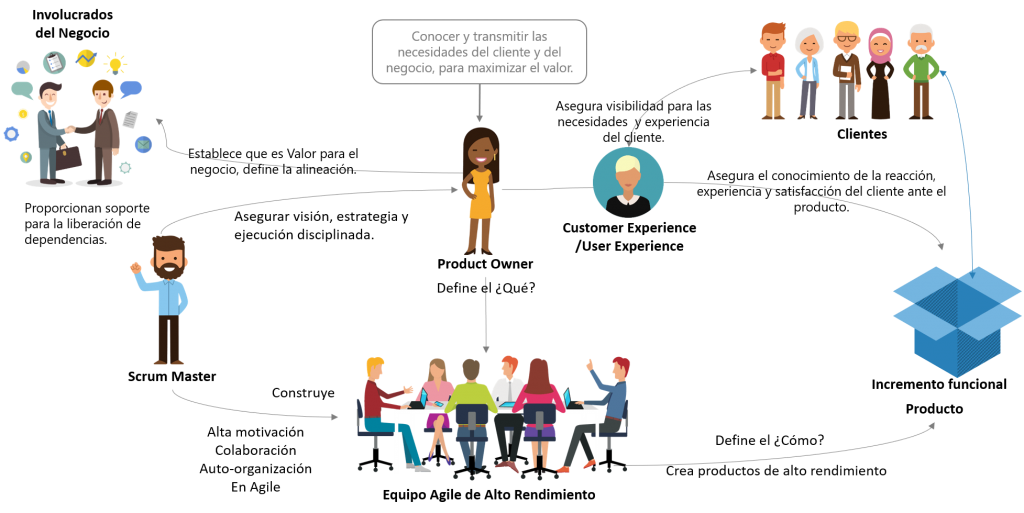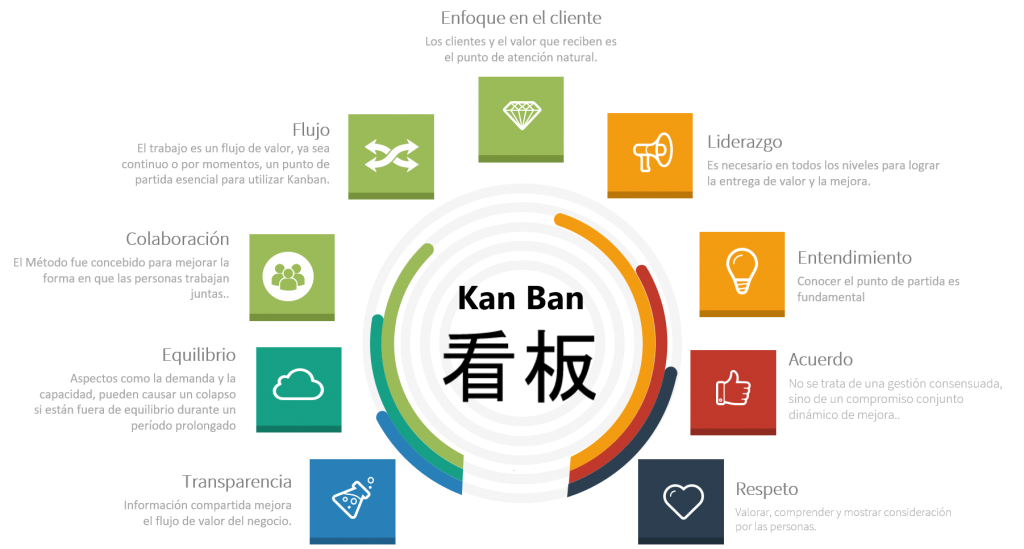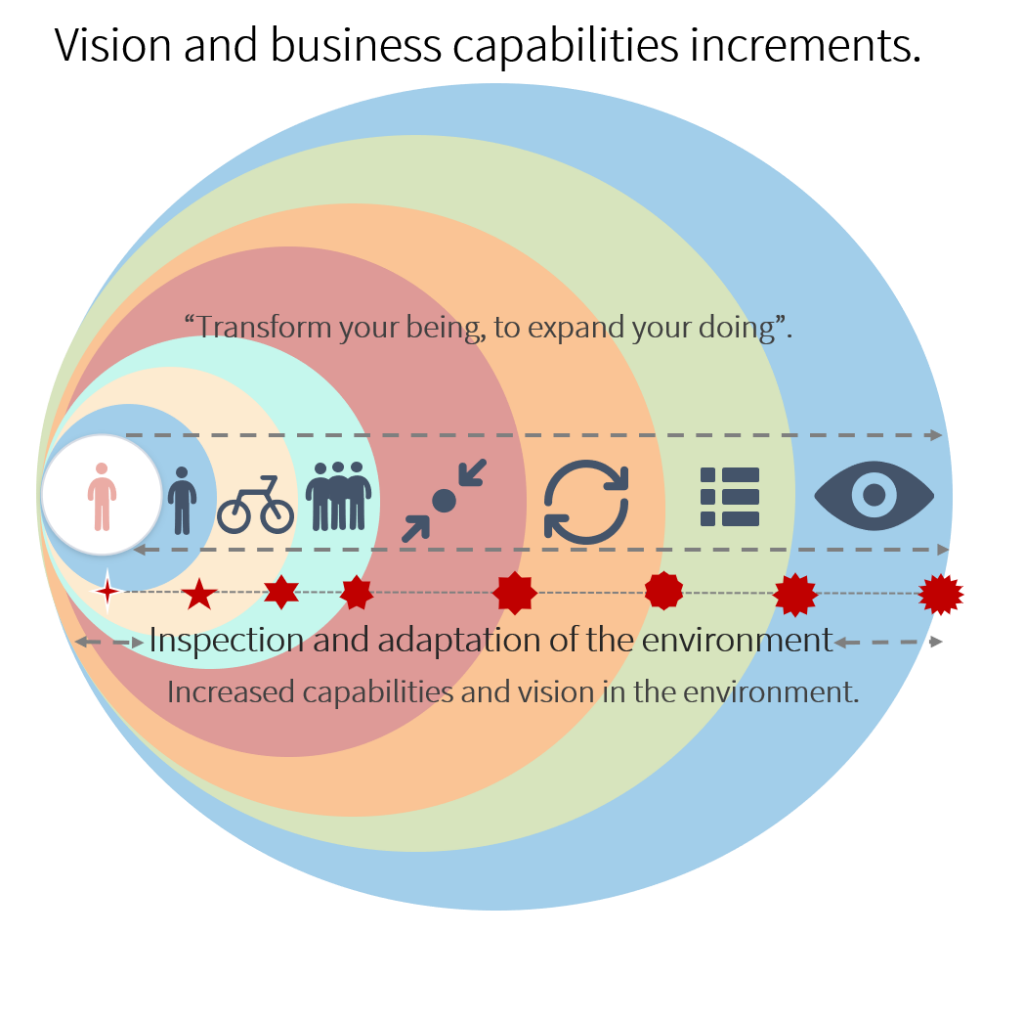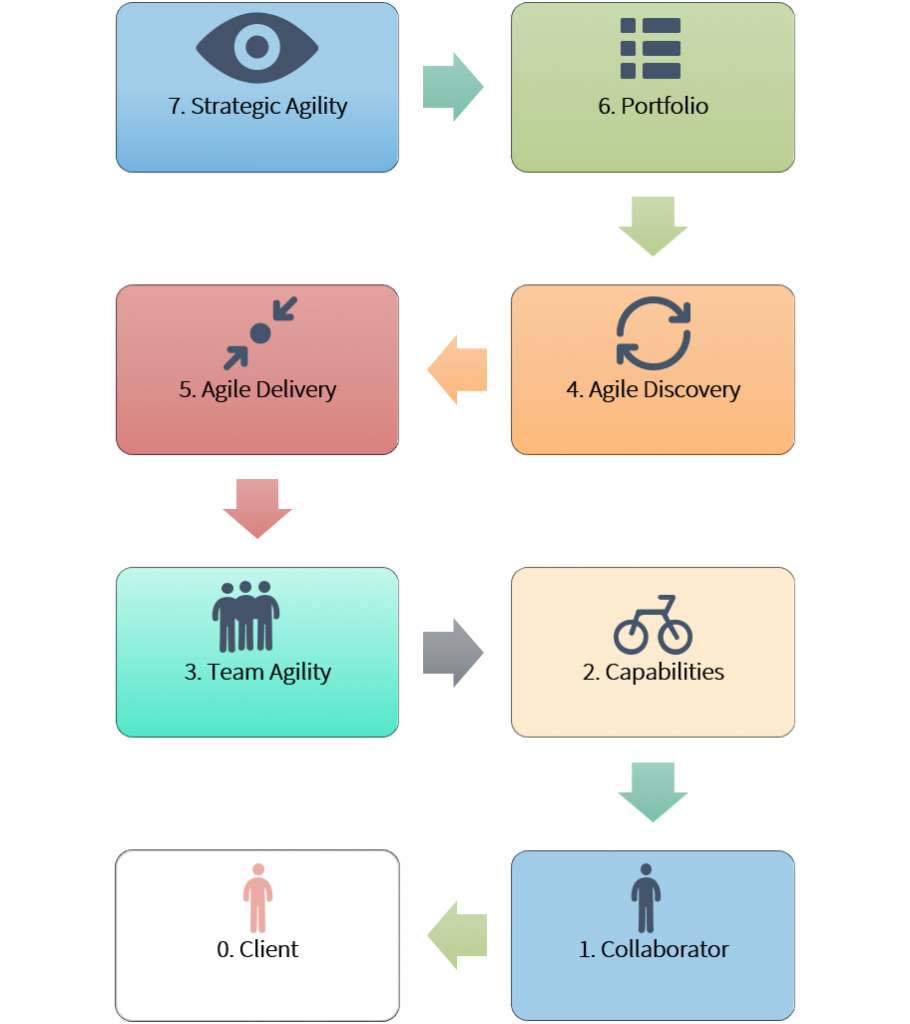La colaboración es como un océano poblado, una extensión gigante e inmaterial de sistemas de comunicación complejos, que habilitan la interacción efectiva de sus habitantes”. Exponential Agility (2020).
En esta fase, si hemos seguido los pasos anteriores, incrementando las capacidades del negocio, lo que obtendremos es un negocio, maduro y sostenido en agile para poder escalar, recordemos que lo que escalamos es la colaboración, y las demás capacidades, la madurez es un objetivo. Lo que queremos es mantener lo más uniforme posible, la productividad y las inversiones en todo nuestro entorno ágil inicial (más de 3 equipos scrum), para lograr esto, necesitamos escalar un conjunto de iniciativas maduras y su interacción entre ellas.
Como hemos visto existen distintos tipos de escalado, escalado vertical, enfocado a la maximización del valor de una iniciativa en concreto hasta convertirla en una iniciativa u organización exponencial.
8.Escalado de Agile
El escalado horizontal, que tiene como objetivo lograr un objetivo con un alcance muy grande a nivel empresarial extendido, para coordinar la integración del valor generado por cientos de equipos participantes en flujos de valor sintetizados. El escalado es un desafío de cambio adaptativo, lleno de “problemas perversos “(wicked problems), como describe el pensamiento de diseño, que son únicos para cada organización. Recordemos que debemos trabajar de forma deliberada e intencionada en la creación, madurez y estabilización de la colaboración, ya que es lo que vamos a escalar, mediante un desarrollo y crecimiento sostenidos.
Cada organización es diferente, aunque el escalado está relacionado con la colaboración, la escalamos, si tenemos problemas en nuestros enfoques de colaboración, tanto verticales como horizontales, los vamos a escalar a su máximo potencial de disfuncionalidad y eso no es lo que queremos. Lo que queremos es mantener lo más uniforme posible la productividad y las inversiones en todo nuestro entorno ágil inicial (más de 3 equipos scrum), para lograr esto, necesitamos escalar un conjunto de iniciativas maduras y su interacción entre ellas.
Por lo tanto, podemos esbozar un meta-backlog de escalado (Parecido a lo descrito en esta serie de artículos), para que cada ciclo (es decir, cada mes) podamos validar nuestra hipótesis principal junto con expertos en escalado para guiar nuestra iniciativa “MVP de Escalado”. Es posible que ni siquiera necesitemos escalar, si podemos lograr una mayor productividad con los equipos que ya tenemos. Hacer ágil con ágil, no escalar ágil con cascada, ¿acaso, existe?.
Figura 1: MVP de Roadmap de Escalado Agile.
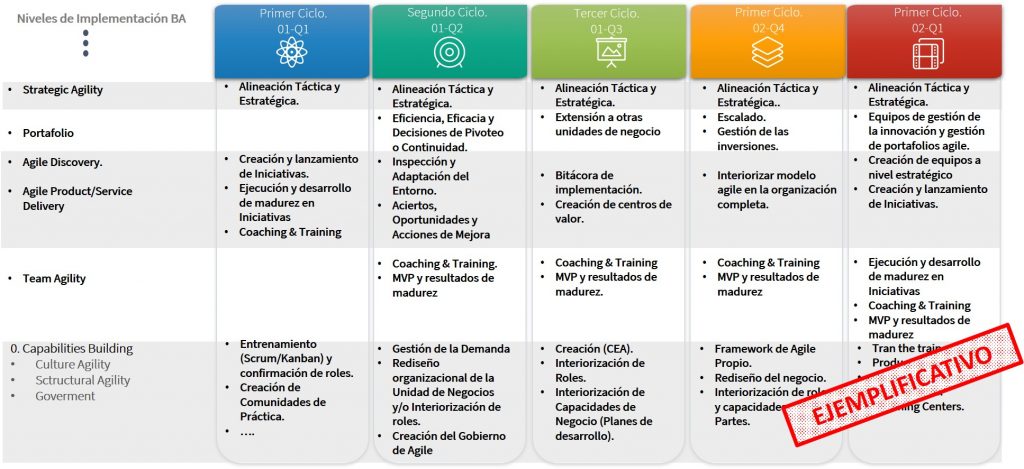
Fuente: Miguel Martínez (2020). Elaboración Propia.
Un desafío de escalado es similar a un escalado empresarial, para nosotros será un “escalado intra-empresarial”, donde tenemos crestas y valles, que debemos identificar, para sortear los obstáculos y lograr el estado futuro, recordemos que debiéramos ejecutar agile con agile, con objeto que las capacidades construidas sean la base de las siguientes, creando así un ambiente de colaboración sostenido.
Figura 2: El Marco de Trabajo de Escalado Nexus.
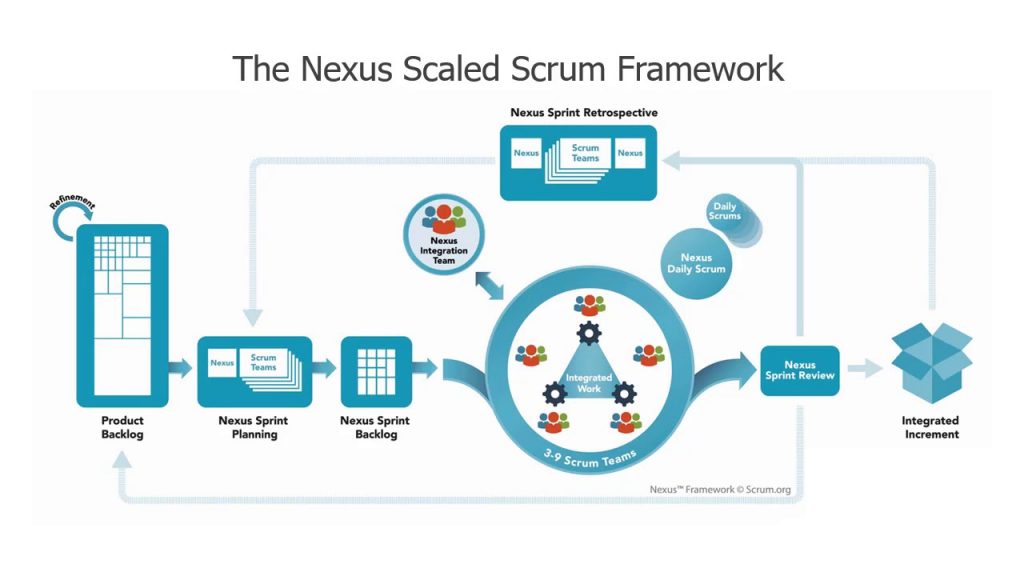
Fuente: Scrum.org.
El centro del escalado reside en identificar, minimizar y remover dependencias, solo con cimientos firmes podemos escalar con éxito. En realidad, podemos producir menos y ser menos eficientes durante un tiempo, ya que los equipos se enfrentan a las complejidades adicionales que conlleva el escalado, por eso es importante la madurez del entorno agile antes de escalar, porque serán menos estos obstáculos y además tendremos equipos fuertes para poder superarlos.
Figura 3: El Marco de Trabajo de Escalado LeSS.
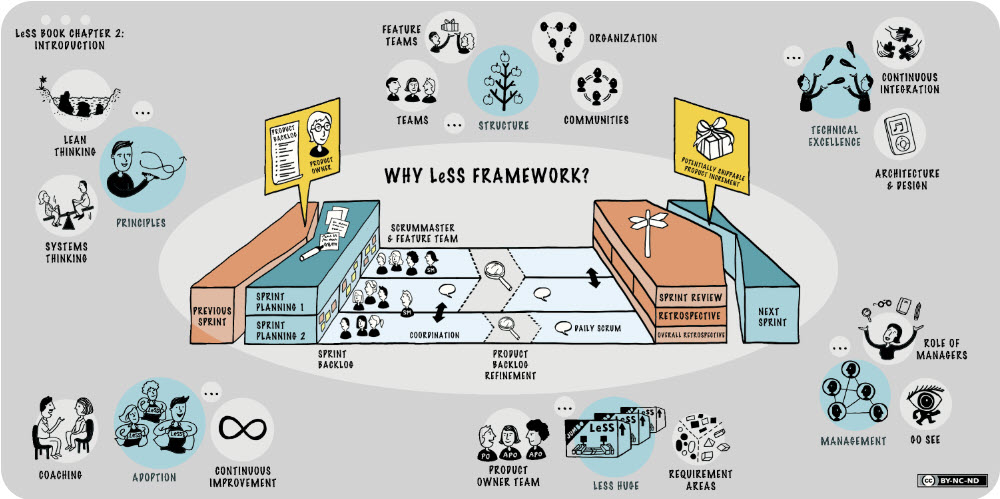
Fuente: less.works
Como tal, es importante aprovechar al máximo los equipos que tenemos actualmente y ayudarlos a ser más eficientes y efectivos antes de buscar escalar sus esfuerzos. Antes de comenzar a escalar, debemos buscar lograr más, con lo que ya tenemos.
Figura 4: El Marco de Trabajo de Escalado SAFE.
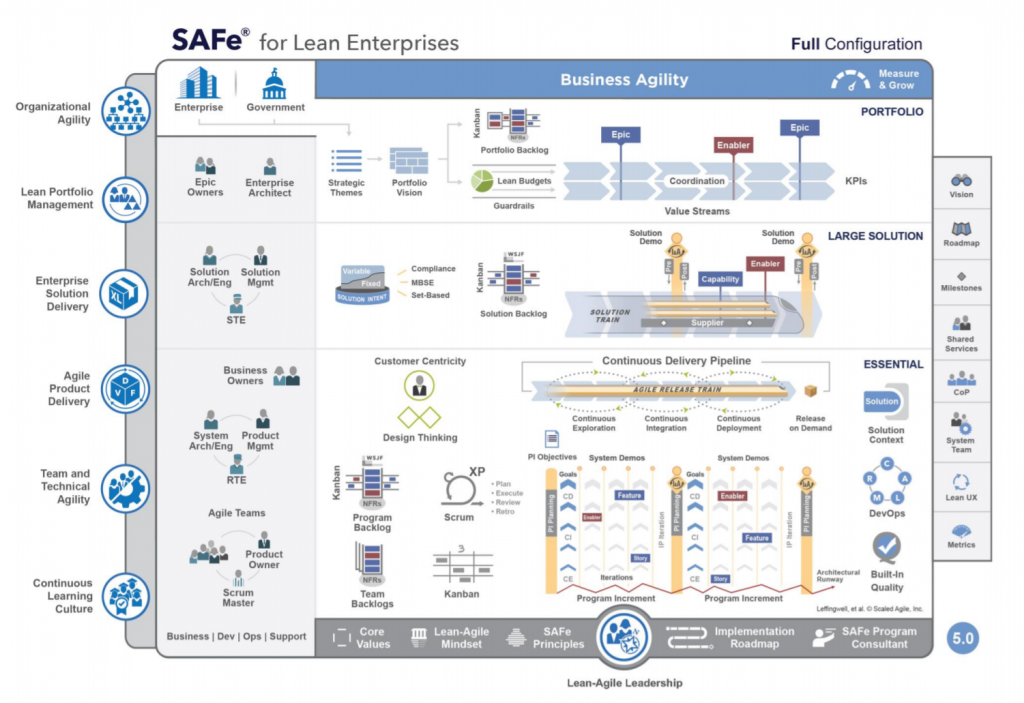
Fuente: scaledagileframework.com
En este punto es muy importante que la gestión de las inversiones esté conectada con los temas estratégicos de la organización, que serán nuestras estrellas del norte a seguir, para coadyuvar o lograr directamente los objetivos del negocio. Desarrollaremos este tema de manera extensa en próximos artículos.
8. Extensión de Blueprints o temas estratégicos.
La gestión lean de portafolios nos proporciona una perspectiva de planificación de más alto nivel en un marco ágil, y se refiere a la definición, refinamiento, priorización y financiamiento de iniciativas de negocio para la realización por parte de programas y equipos de entrega. Estas iniciativas se denominan regularmente épicas y una vez aprobadas en el nivel de portafolio, se traducen en características implementables, que deben realizar los equipos de programas de entrega. Un programa es una colección de productos vinculados, involucra múltiples equipos de colaboradores.
Cada unidad de negocios dentro de una empresa tendrá un portafolio de productos y / o servicios generadores de ingresos. Cada portafolio está guiado por una estrategia, o conjunto de Temas Estratégicos, y respaldada por las personas y los procesos necesarios para llevar a cabo esa estrategia. Los artefactos a nivel de portafolio incluyen:
Temas estratégicos, épicas (épicas de negocios y de habilitadores), un Kanban de Portafolio y un Backlog de Portafolio. Define el conjunto total de acciones requeridas para llevar un producto/servicio desde su caracterización hasta su puesta en operación.
Figura 5: Portafolio basado en temas estratégicos.
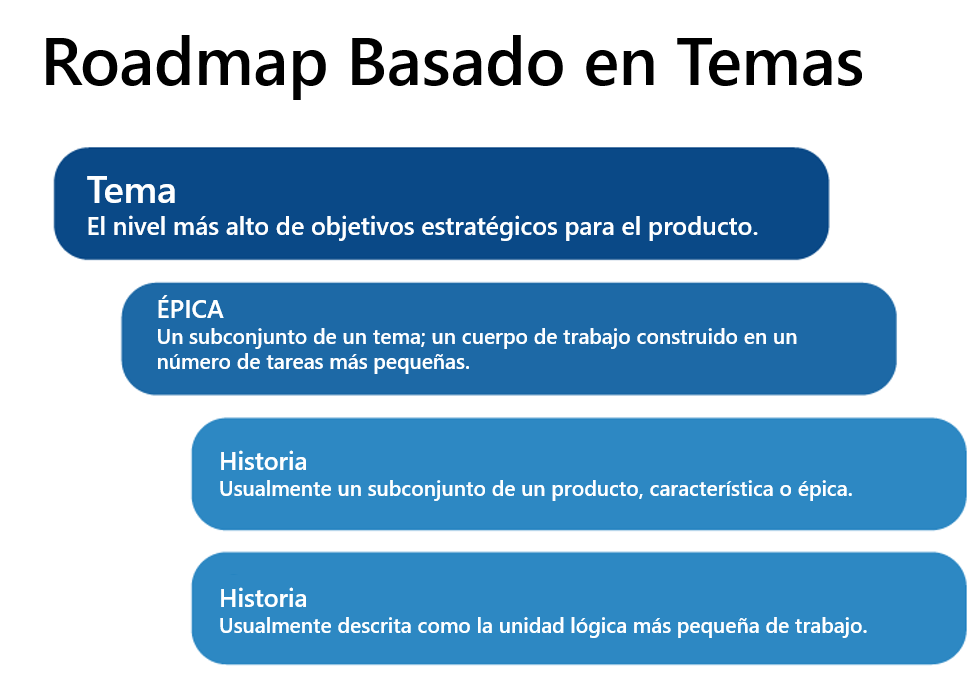
Fuente: productplan.com/theme-based-roadmap/
La alineación institucional incluye, al liderazgo organizacional, el conocimiento de la visión, estratégica y táctica del negocio, y de la alineación de cada programa, visión, estrategia y táctica de producto como flujo de valor, es muy importante el compromiso de los diversos implicados en el proceso con objeto de mantener flexibilidad y estabilidad de la estrategia al mismo tiempo, una práctica que nos ayuda para mantener alineado un entorno y prepararlo para escalar es la práctica de agile product management, ya que los artefactos que genera nos permitirán integrar el valor de cada una de las iniciativas al momento de ejecutar los flujos de valor correspondientes.
Cuando trabajamos en la creación de un entorno de trabajo agile es muy importante que los líderes del negocio, a nivel dirección, conozcan el valor de la agilidad y lo sepan apalancar para obtener resultados contundentes, la cultura no debe comerse a la estrategia en el desayuno, los líderes son los encargados de que esto no suceda y son quienes pondrán el ejemplo en la co-creación de estas capacidades.
Como experiencia práctica en una transformación, al interactuar en este nivel: “Era la primera de diversas reuniones que sosteníamos al respecto, nuestra agenda constaba de socialización de la visión, estrategia y táctica de cerca de 15 productos/servicios en una unidad de negocio digital bancaria, había que compartir la visión y estrategia, alineadas a la estrategia de transformación del banco, era nuestro primer paso temprano hacia un escalado inminente, habíamos estado usando Nexus, como base de trabajo y buscábamos complementarlo con una práctica de Lean Portfolio Management. En las primeras tres presentaciones, los ejecutivos presentes en la sesión, no estaban acostumbrados al nivel de transparencia mostrado, no entendían por qué debía haber estrategia a ese nivel, porque había de repetirse, la estrategia en ese momento solo correspondía al CEO y a su staff, a nadie más, la cultura estaba siloficada, con unos 10 bastiones, quienes fungían como los propios CEOS de sus unidades de negocio, que se gestionaban por resultados y cada una por separado, existían proyectos que se traslapaban y una de las labores del CEO era identificarlos, pero en definitiva la cultura está prevista a que la estrategia estaba dividida y no era transparente, recuerdo que la primera sesión duro hasta que los ejecutivos presentes pidieran la firma de los compromisos que estaban establecidos en los roadmaps agile de cada producto, estos no deberían cambiar y la perspectiva debía de ser de al menos 1 año”, esas fueron las indicaciones. Realizando una inspección y adaptación de esta sesión, procedimos a identificar los elementos de mejora, tardamos aproximadamente de 3 a 6 meses, en cada caso, para cambiar esta perspectiva mediante awareness, capacitación a estos niveles, entrenamiento en estrategia agile y gestión de producto. La siguiente sesión, a los 3 meses siguientes nos fue mucho mejor, teníamos una asistencia de al menos 10 interesados a nivel ejecutivo, con una preparación sincrética previa, en la cual revisamos previamente los puntos relevantes a mostrar, los problemas y las decisiones a tomar de una forma sintética y ejecutiva, solo un caso hubo que retrabajar la información de una iniciativa. Eso fue un planeamiento clave de como empezamos a modificar la cultura y ganar los compromisos requeridos a nivel directivo.
Figura 6: Temas Estratégicos en SAFE.
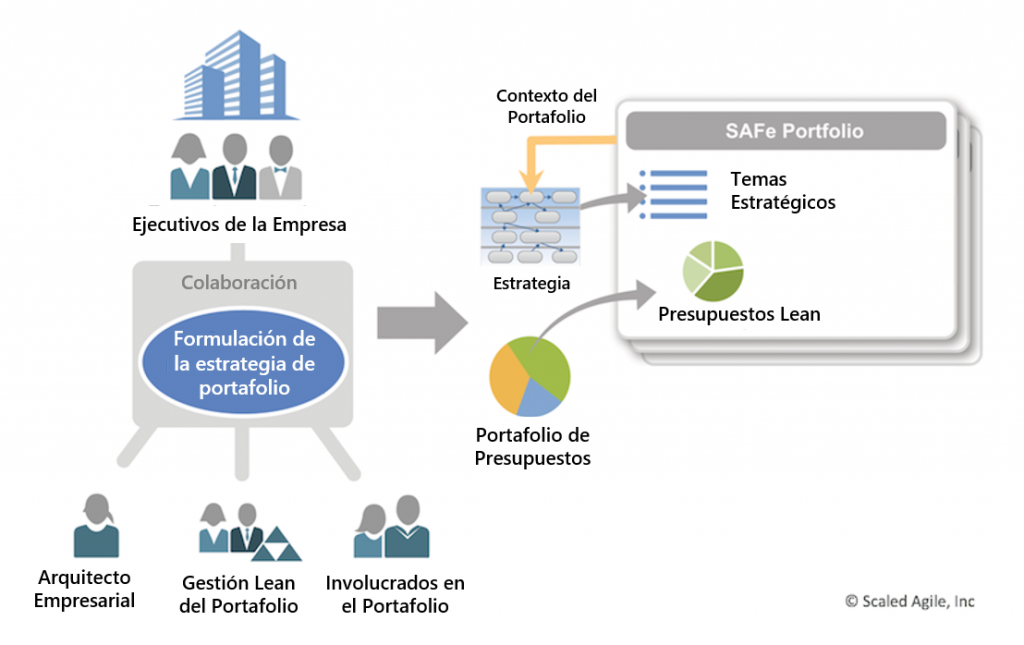
Fuente: www.scaledagileframework.com/strategic-themes/
Uno de los siguientes pasos implicaba, que tal como habíamos creado equipos a nivel operacional, a nivel táctico, era importante crear equipos de priorización a nivel estratégico, equipos autoorganizados, con roles parecidos a scrum o Kanban, pero donde las decisiones acerca de los productos y experimentos fueran colegiadas, así como también el fondeo de diversos proyectos, finalmente aplicaban Scrum o Kanban, pero a otro nivel, había que hablar con estos equipos a nivel de inversiones, beneficios, impacto al cliente, financiero al negocio, reducción de costos, ahorros, recuperamiento de las inversiones, riesgos, siendo scrum o Kanban la misma base pero personalizada al contexto donde nos encontrábamos, ello permitió crear equipos de priorización de portafolios a nivel estratégico, lo que permitió un gran progreso en la transformación con respecto al aplanamiento de las estructuras jerárquicas, obviamente siempre existieron las figuras antagónicas que nos dieron mayor impulso en la mejora continua.
El día de hoy avanzaremos hasta aquí, si tienes duda o comentarios al respecto, siéntete con total libertad de contactarnos directamente y preguntarnos.
Muchos saludos.
Miguel A. G. Martínez H., septiembre 2020,
Bibliografía:
- AG, D. (2020, March 10). Respond and Recover | Crisis management in unprecedented times. Retrieved August 20, 2020, from https://www2.deloitte.com/us/en.html
- Allas, T., Sjatil, P. E., Stern, S., & Windhage, E. (2020, April). How European businesses can position themselves for recovery. Retrieved September 10, 2020, from https://www.mckinsey.com/
- Dreyfus model of skill acquisition. (2020, June 18). Retrieved September 18, 2020, from https://en.wikipedia.org/wiki/Dreyfus_model_of_skill_acquisition
- Mahadevan, D. (2018, February 20). ING’s agile transformation. Retrieved September 19, 2020, from https://www.mckinsey.com/industries/financial-services/our-insights/ings-agile-transformation
- Mitchell, C. (n.d.). The Conference Board – TCB C Suite Challenge 2020 Covid19 Recovery. Retrieved September 10, 2020, from https://conference-board.org/us/
- LEANTALK, 2020. The Ultimate Lean Talk Forum And Blog- About Us. [online] Leantalk.org. Available at: <https://leantalk.org/about-leantalk-org> [Accessed 14 September 2020].
- One, V. (n.d.). 14th Annual State of Agile Report. Retrieved September 10, 2020, from https://stateofagile.com/
- O’rreally, B. (2020, May 11). Scaling Innovation Means Descaling Work. Retrieved September 10, 2020, from https://barryoreilly.com/resources/
- Saenz, H., Supko, M., & O’Keefe, D. (n.d.). Why Return to “Normal” When You Can Recover to a Winning Position? Retrieved September 10, 2020, from https://www.bain.com/










